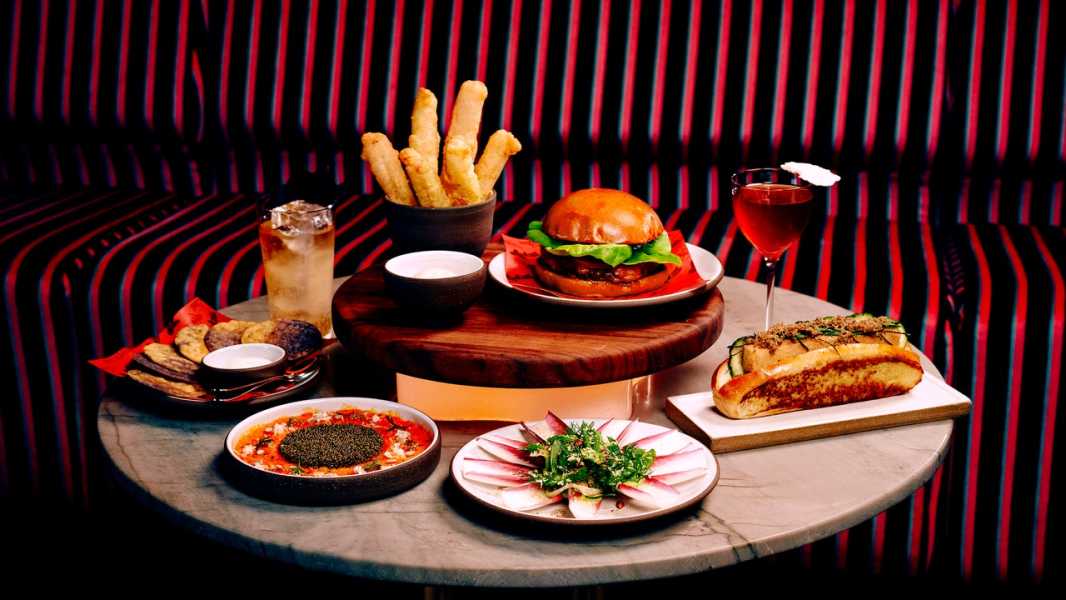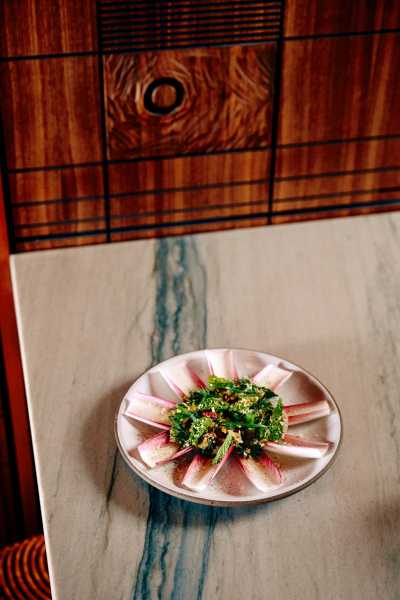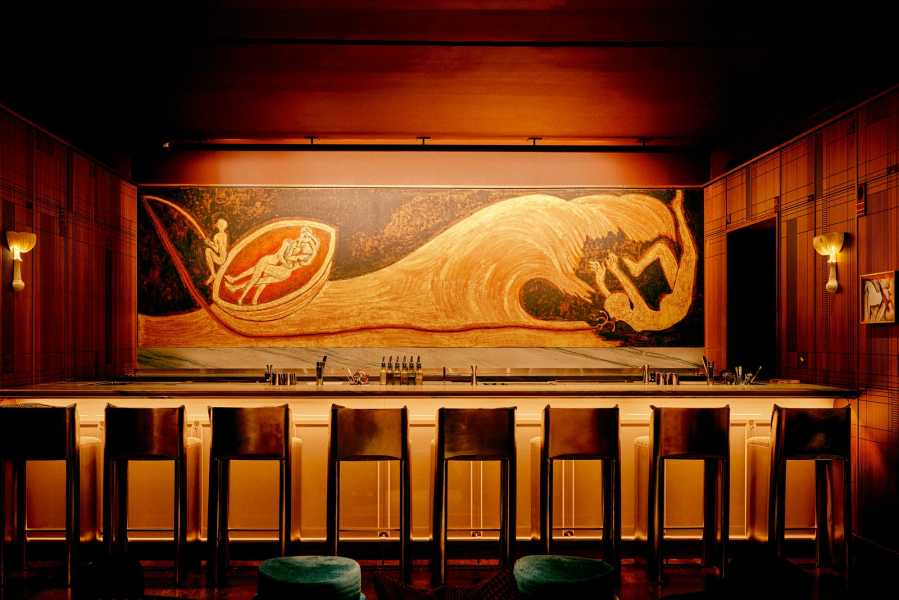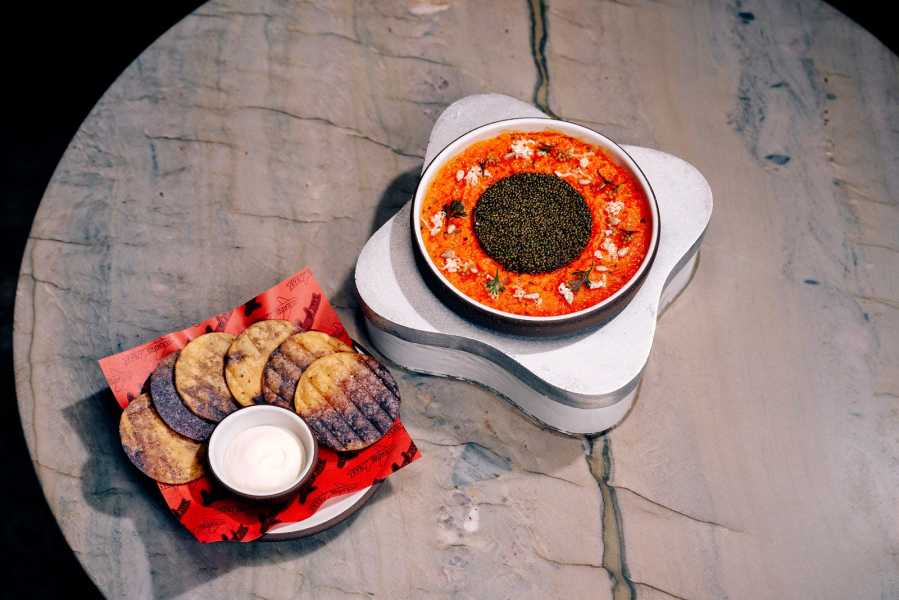
Save this storySave this storySave this storySave this storyYou’re reading the Food Scene newsletter, Helen Rosner’s guide to what, where, and how to eat. Sign up to receive it in your in-box.
The Michelin-star obsessives and tasting-menu connoisseurs of the world love to chatter about whether or not Eleven Madison Park is “worth it.” In 2017, E.M.P., as it’s often referred to, was ranked Earth’s top restaurant by the World’s 50 Best organization. In 2021, after various stylistic experiments and management reshuffles, Daniel Humm, the Swiss chef who is now the restaurant’s sole operator, announced that, while E.M.P. would remain every bit as starched and choreographed as before, it would be transitioning to an entirely plant-based kitchen. Without the standard-issue luxury larder—your osetra caviars, your muscovy ducks—but with the multi-hundred-dollar price tag unchanged, E.M.P.’s reinvention prompted questions of merit and value: Could a pampered beet worthily stand in for foie gras? Could nuts and seeds satisfy a yen for loin of venison? Reviews over the years, both official and crowd-sourced, have been decidedly mixed; the consensus seems to be that the glamour, the precision, the aesthetic grandeur of the place remain—but the actual food itself, over the lips and past the gums, is a bit more hit-or-miss.
Last month, Humm opened Clemente Bar, a sort of independent city-state within Eleven Madison Park, occupying a former private dining room that you get to by passing through the main entrance and ascending an interior flight of stairs. The same conversations regarding calibre and cost will undoubtedly extend to this new operation, which is distinct from its downstairs sibling in the way the front row of business class is distinct from the final row of first. But in a bar—and, despite the presence of a food menu, Clemente Bar is very much a bar—the calculus is different, the stakes are lower. Here, you can drop in for a drink and a snack, and invest a hundred bucks into a renowned chef’s artistic vision rather than a thousand.

The “endive goddess.”

A cocktail with an embossed ice cube.
On a recent visit, Clemente Bar’s cozy space seemed to be populated mostly by well-employed millennial gastronomes, plus a smattering of Eleven Madison Park regulars who were discernible by their unplaceable European accents and their attitudes of ultra-high-net-worth dispassion. My companion and I widened our eyes at the arrival of a pneumatic blonde in a black-sequinned Chanel jacket, and her companion, a leonine man of late middle age with a shirt unbuttoned to the sternum and an honest-to-goodness cravat. Servers, energetic and exquisitely friendly, crouched by the low tables to advise on the dryness of a Martini or answer a diner’s queries about the menu’s fourteen-dollar “thrice fried potato.” (The answer, in so many words, is: It’s french fries. You get eight of them.) In contrast to the chilly whites and grays of the main restaurant, Clemente Bar is warm and dark, done up in plush burgundies and golds, with soft carpets underfoot, dim lighting, and poufs and banquettes arranged around knee-bruisingly low tables. The room is windowless, save a slim interior aperture looking down over the Busby Berkeley whirl of the restaurant action below.
The room’s perpetual dusk is a cunning frame for works by the seventy-two-year-old Italian artist Francesco Clemente—the bar’s namesake and patron saint—which fill nearly every vertical surface, and at least one patch of ceiling. In the walled-in gloaming, the paintings and frescoes have the weighty vagueness of Very Expensive Restaurant Art, pleasingly decorative. Clemente is known for creating expressive, symbolically rich scenarios, mystical and dreamlike, with a puckish current of sex and lust; upon closer examination, his works here reveal a frank horniness that feels thrillingly out of character for the self-serious hospitality machine around it. The several dozen subjects of a ceiling painting above the stairwell press against one another orgiastically. Over the bar, nudes entwine in and around an unabashedly vulvar boat, as the vessel rides the rising crest of a golden wave.

The room serves as a showcase for works by the Italian artist Francesco Clemente, who gives the bar its name.
Upstairs, as downstairs, Humm is a master of the exquisite plate. Slim petals of pink endive radiate out from the green eye of a gremolata-like goddess dressing, minty and herbaceous with fennel and candied pistachio. An array of vegetables, pickled in sake lees, are tournéed like rough jewels, draped in ribboned shiso, and sprinkled with sesame seeds. An orange disk of fine-textured carrot tartare is topped with a shining black circle made of thousands of tiny tonburi, the seeds of the Japanese summer cypress. A staple of the downstairs menu, they are a rare, expensive ingredient that, in dining rooms like these, are presumably called into service because of their resemblance to caviar. The result is certainly the most beautiful plant-based dish in the city, but its thrills end with the visuals. The tonburi seeds taste a little bit like rain and grass, but mostly they taste like nothing. The carrot tastes watery, like raw carrot. The sake pickles taste like the cucumber salad at the Taiwanese dumpling chain Din Tai Fung. A few of the small plates riff on bar food—the fries, indeed thrice fried, are quite good, though entirely extortionate—but the whole high-low thing feels more snobbish than playful, especially an haute hot dog made with agedashi-style fried tofu, floppy and flavorless, that comes buried under shreds of black truffle as dry and dull as hamster bedding.

A carrot tartare is topped with tonburi, the seeds of the Japanese summer cypress, which bear a resemblance to caviar.
The cocktails, at least, are terrific, which is no surprise—E.M.P. has always been a restaurant that understands the allure of an original drink. These, created by the bar director Sebastian Tollius, are the opposite of Clemente Bar’s food: unassuming in the glass, almost solemn, but thrilling on the tongue, making clever use of savory and (creamless) creamy notes. A Negroni Colada, made with clarified coconut milk, brings a lascivious roundness to the classic, austerely garnished with a frozen disk of bitter Campari whose slow melt dynamically changes the drink’s flavor as you sip. The Army Brat, an ingenious riff on the Army & Navy, swaps the original’s lemon and almond orgeat for vivid yuzu and cashew flavors. A cherry-blossom vodka drink is a screwball comedy in a glass, girlish and fizzy; a hint of miso makes it almost cola-like, and a crowning layer of dense white foam is zippy with salt. At twenty-five-ish dollars apiece, the beverages are priced on par with other fancy drinks in this town, which genuinely feels like a bargain.
Helen, Help Me!
E-mail your questions about dining, eating, and anything food-related, and Helen may respond in a future newsletter.
The people-watching at Clemente Bar, too, is second to none, and tidily illustrative of New York’s social hierarchies. When Humm himself stepped into the room, his chef’s whites blazing like a beacon, he headed first to a woman clad throat-to-calf in black leather, chic and terrifying, who was sharing a corner booth with a broad-shouldered stallion dripping in manly rings and bracelets. There were hugs and double-kisses, and mutual expressions of delight. Humm moved a few tables down, to a businesslike pair of buff-haired men in starched autumnal linen, to repeat the ritual. Then he left—no hello to the sequinned Chanel, not so much as a nod to any of the rest of us—and the energy in the room shifted. It was impossible not to notice that the chef had arrived to make the rounds, or that those rounds had been, perhaps, something of a pointillist exercise. It doesn’t take much to get a table at Clemente Bar—anyone can set a few Resy alerts and be inundated with day-before options—but it seems to take a little more to get a hello. When Humm slipped back into the room, a few minutes later, now in civilian gear, and settled in with one of the previously anointed parties, he sat facing away from the crowd, and never turned around. ♦
Sourse: newyorker.com






